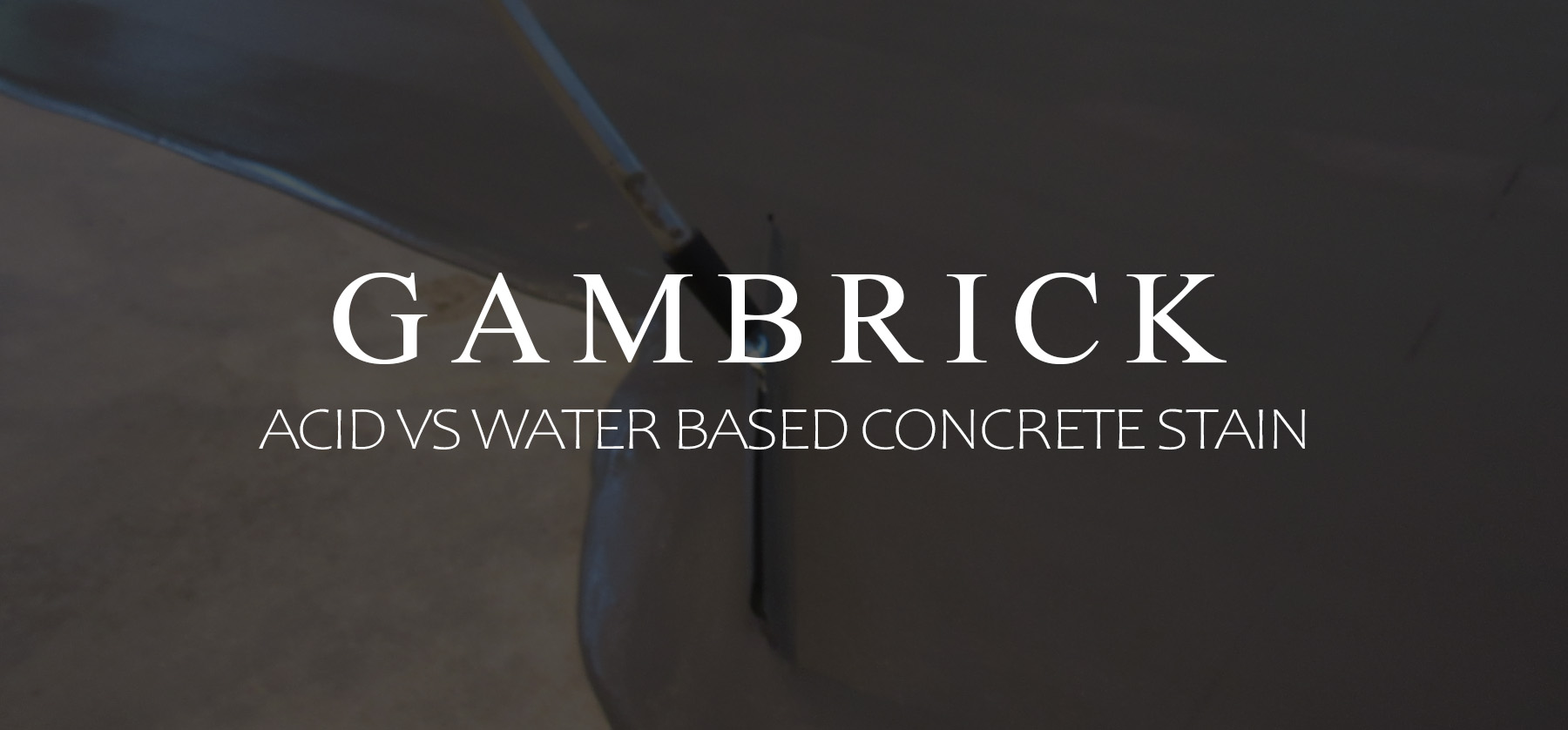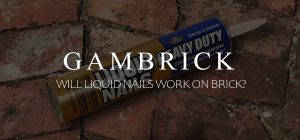
Acid Vs Water Based Concrete Stain
I’ve been a mason for over 25 years and can tell you firsthand that the main difference between an acid stain and a water based concrete stain is how they interact with the concrete. Acid stains have a muted more natural coloring. They penetrate into the concrete’s pores and interact with it’s natural coloring. Acid stains actually change the color of the concrete by permanently staining it. They’re very durable and great for outdoor use. On the other hand, water based concrete stains act more like a paint. They sit closer to the surface and don’t permanently change the concrete’s color. Because of this, their colors can be bolder and more vibrant. They’re also less durable and better for indoor use.
Stains work on old concrete and brand new concrete, however, if the slab is damaged, make repairs before staining.
Which type of concrete stain is best depends on the project, because they’re both great at doing different things. But whichever stain you choose, you need the right tools to apply it. Use high quality rollers that are thick enough to penetrate into concrete’s deep pores. You’ll also need tough nylon brushes that won’t get chewed up by the concrete’s gritty texture.
What Is A Stain?
Concrete acid stains are a way to color concrete. But they work very different from a water based stain or paint.
Unlike concrete paint or water based stains, acid does not sit on the surface of the concrete. Rather, it penetrates deep into the pores of the concrete and actually changes it’s color forever. This means that acid stains are extremely durable because they’re not a thin surface layer. They don’t chip, flake, peel or crack off. Acid stains are a permanent coloring. This extreme durability makes acid stains much better for outdoor use or areas that get a lot of foot traffic. Although the colors are earthy because the stain works with the concrete’s natural coloring.
Concrete is a porous material. However, water based stains are too thick to penetrate into it’s deep pores like an acid. So water based stains are more like a paint. They sit on top of the concrete’s surface. They don’t interact and change the concrete’s color. Rather, they’re more of a simple coloring. Water based concrete stains are not considered permanent and so are not as durable. They’re better for indoor use. Because the stain does not interact with the concrete, the colors are bolder and more vibrant.
Stains are very popular for indoor, outdoor, commercial, and residential use on concrete. It’s important to seal concrete after it’s been stained to help protect it from damage. However, this is even more important with water based stains because the sealant not only protects the concrete itself, but also the coloring.
Concrete Stain Vs Paint
Paint is much thicker than stain and only a surface level coating. It can chip, crack, peel, deteriorate and fade. On the other hand, stain doesn’t chip, crack, peel or deteriorate and the color stays true for much longer.
Another benefit of using a stain is that they’re semi translucent. This means that you can see some of the concrete beneath the coloring. If you’ve got a concrete with aggregate stones that show, this can be a big advantage because the coloring looks more natural. Stained concrete is a unique look because it works with the concrete rather than simply covering it up with thick opaque color. Painted concrete looks very artificial.
Both acid and water based concrete stains work with the concrete’s existing color to varying degrees. Acid transforms it to permanently alter it’s color. Water based stains are semi translucent so some of the concrete’s color comes through. Paint is opaque so you don’t see any concrete at all. Things that affect the look of concrete stains are:
- The concrete’s original coloring.
- The ingredients used to make the concrete effect how acid interacts with it.
- Type and size of the aggregate used to make the concrete.
- Finishing methods.
- The age, moisture and weather conditions content of the concrete when you apply the stain.
Many factors are involved in determining which is best, acid vs water based concrete stains. But in general, both are considered better options than paint.
Acid Stain
Acid stain is reactive. It’s final color is as much about the concrete your staining as the stain itself. It’s very thin and penetrates deep into the concrete’s pores. The acidic solution contains metallic salts that react with the lime content inside the concrete. This chemical reaction causes the concrete’s color to change by forming a permanent bond with the concrete. You don’t need to worry about peeling, cracking, or deterioration of the color layer because there isn’t one. With an acid stain, it’s the concrete itself that’s changed color.
Acid stains create a more natural look. They come in a variety of colors, but they’re all pretty earthy. Lots of browns, greens and oranges. Acid stains look more like a tint that a true coloring because so much of the original color is still there. The finished color is duller and still looks like concrete. And because they work because of a chemical reaction between the concrete and acid, the end result will vary based on what you apply it to. This creates a more unique look.
Acid stain is applied and left to dry anywhere from 4 to 24 hours. The longer you let your stain set, the deeper the color will become.
The best part about acid stains is that they last as long as your concrete does. It’s a permanent coloring that doesn’t need any upkeep. Protecting the concrete will also protect the color.
The average cost of an acid stain is $50.00 per gallon. If you hire a professional to stain your concrete, it will cost between $7.00 and $15.00 per square foot on average in addition to the cost of the stain. You also need to make sure the concrete is clean and dry before applying the stain. If this needs to be done by a Pro then it will cost extra for the time it takes and cleaning supplies.
We use an alkaline agent after the stain has set. This typically cost about another $1 per square foot. It’s a good last step because it stops the coloring process.
Finally, you’ve got the sealing. It’s highly recommended to seal exterior concrete. It not only protects the coloring but also the concrete. Sealants can also contain a gloss which gives an added dimension to the finish. And most sealants also enhance the color by making them look deeper and more rich.
Water-based Concrete Stain
Water-based concrete stains are non reactive. They’re made up of water-based acrylics that deposit permanent color onto the concrete and into it’s surface level pores. It’s thicker than acid and doesn’t penetrate as deep, so water-based stains act more like a paint. Because of this, the colors are bolder and more vibrant. When comparing acid vs water-based stains, it’s very important to consider the application and goals of the project.
Because water-based stains sit on the surface and don’t actually react and change the color of the concrete, they’re more delicate. They’re still more durable than paint but not nearly as tough as an acid. They’re also more opaque and don’t use as much of the concrete’s natural coloring. This makes them appear more artificial.
Similarly to acid stains, water-based concrete stains will last as long as your concrete does. However, the color does fade more than an acid stain and will degrade along with the concrete’s surface.
Because water-based stains aren’t as durable, and are more colorful, they’re typically used indoors or outdoors as an accent. Many people will use acid stains for the bulk of a slab and water-based for borders or special features they want to highlight.
It’s highly recommended that you seal concrete that’s been stained with water-based products. It’s important to not only protect the concrete but also the color layer.
The average cost of water-based concrete stains is the same as acid-based, about $50.00 per gallon. Application from a Pro is also the same, falling between $7.00 and $15.00 per square foot.
Sealing is extra important with water-based concrete stains.
Which Concrete Stain Is Best
Acid vs Water-based concrete stains. Which is best. Both choices are great for staining concrete, but it’s important to remember that there’s no clear cut winner. They each have they’re strengths and weaknesses. Choose a stain that’s best for your particular project, where it’s located and the finished look you want.
This chart outlines the similarities and differences between acid vs water-based concrete stain.
| Type of Stain | Components | Qualities | How Long It Lasts | Average Cost |
| Acid Stain | An acidic solution with reactive metallic additives | Natural Appearance. Durable. Permanent coloring. | Permanent. Sealing is recommended, it helps protect the concrete which also protects the color. | $50 per gallon of stain plus $7-$15 per square foot for installation |
| Water-based Stain | Water-based acrylics | Bolder more vibrant colors. More durable than paint but not as durable as acid. | More permanent than paint but not as much as acid. Can fade over time. Should always be sealed. | $50 per gallon of stain or $7-$15 per square foot from a contractor |
As you can see from the chart above, the biggest difference between these two stains is the color and how long it lasts. Once you decide on the look you’re going for, choose a stain to match.
Make sure to respect the conditions and location where your staining. Acid is very durable and can be used anywhere. However water-based stains are more delicate and should always be sealed.
Summary: Acid Vs Water Based Concrete Stain
I’ve been a mason for over 25 years and can tell you firsthand that the main difference between an acid stain and a water based concrete stain is how they interact with the concrete. Acid stains have a muted more natural coloring. They penetrate into the concrete’s pores and interact with it’s natural coloring. Acid stains actually change the color of the concrete by permanently staining it. They’re very durable and great for outdoor use. On the other hand, water based concrete stains act more like a paint. They sit closer to the surface and don’t permanently change the concrete’s color. Because of this, their colors can be bolder and more vibrant. They’re also less durable and better for indoor use.
Stains work on old concrete and brand new concrete, however, if the slab is damaged, make repairs before staining.
Which type of concrete stain is best depends on the project, because they’re both great at doing different things. But whichever stain you choose, you need the right tools to apply it. Use high quality rollers that are thick enough to penetrate into concrete’s deep pores. You’ll also need tough nylon brushes that won’t get chewed up by the concrete’s gritty texture.
If you have any questions or comments email us any time.

John Mazzuca | About | More Posts |
Custom Home Builder
John Mazzuca is a custom home designer and builder at Gambrick with over 25 years experience in the construction industry. John has designed, built and/or remodeled hundreds of homes, small buildings, and commercial projects. He writes about business, real estate, home building, and household electronics. His work has been featured in Fox Business, Better Homes & Garden, House Beautiful, and more.




















